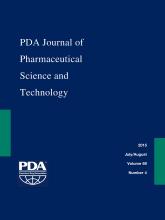Abstract
When isolator technology is applied to biotechnology drug product fill-finish process, hydrogen peroxide (H2O2) spiking studies for the determination of the sensitivity of protein to residual peroxide in the isolator can be useful for assessing a maximum vapor phase hydrogen peroxide (VPHP) level. When monoclonal antibody (mAb) drug products were spiked with H2O2, an increase in methionine (Met 252 and Met 428) oxidation in the Fc region of the mAbs with a decrease in H2O2 concentration was observed for various levels of spiked-in peroxide. The reaction between Fc-Met and H2O2 was stoichiometric (i.e., 1:1 molar ratio), and the reaction rate was dependent on the concentrations of mAb and H2O2. The consumption of H2O2 by Fc-Met oxidation in the mAb followed pseudo first-order kinetics, and the rate was proportional to mAb concentration. The extent of Met 428 oxidation was half of that of Met 252, supporting that Met 252 is twice as reactive as Met 428. Similar results were observed for free L-methionine when spiked with H2O2. However, mAb formulation excipients may affect the rate of H2O2 consumption. mAb formulations containing trehalose or sucrose had faster H2O2 consumption rates than formulations without the sugars, which could be the result of impurities (e.g., metal ions) present in the excipients that may act as catalysts. Based on the H2O2 spiking study results, we can predict the amount Fc-Met oxidation for a given protein concentration and H2O2 level. Our kinetic modeling of the reaction between Fc-Met oxidation and H2O2 provides an outline to design a H2O2 spiking study to support the use of VPHP isolator for antibody drug product manufacture.
LAY ABSTRACT: Isolator technology is increasing used in drug product manufacturing of biotherapeutics. In order to understand the impact of residual vapor phase hydrogen peroxide (VPHP) levels on protein product quality, hydrogen peroxide (H2O2) spiking studies may be performed to determine the sensitivity of monoclonal antibody (mAb) drug products to residual peroxide in the isolator. In this study, mAbs were spiked with H2O2; an increase in methionine (Met) oxidation of the mAbs with a decrease in H2O2 concentration was observed for various levels of spiked-in peroxide. The reaction between Met and H2O2 was 1:1, and its rate was dependent on mAb and H2O2 concentrations. Consumption of H2O2 by Met followed pseudo first-order kinetics; the rate was proportional to mAb concentration. Formulations containing trehalose or sucrose had faster consumption rates than formulations without the sugars, which could be due to excipient impurities. Based on H2O2 spiking study results, we can predict the amount of Met oxidation for a given mAb concentration and H2O2 level. Our modeling of the reaction between Fc-Met oxidation and H2O2 provides an outline to design a H2O2 spiking study that supports using VPHP isolators during manufacture of mAb products.
- © PDA, Inc. 2015
PDA members receive access to all articles published in the current year and previous volume year. Institutional subscribers received access to all content. Log in below to receive access to this article if you are either of these.
If you are neither or you are a PDA member trying to access an article outside of your membership license, then you must purchase access to this article (below). If you do not have a username or password for JPST, you will be required to create an account prior to purchasing.
Full issue PDFs are for PDA members only.
Note to pda.org users
The PDA and PDA bookstore websites (www.pda.org and www.pda.org/bookstore) are separate websites from the PDA JPST website. When you first join PDA, your initial UserID and Password are sent to HighWirePress to create your PDA JPST account. Subsequent UserrID and Password changes required at the PDA websites will not pass on to PDA JPST and vice versa. If you forget your PDA JPST UserID and/or Password, you can request help to retrieve UserID and reset Password below.






